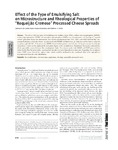Use este identificador para citar ou linkar para este item:
http://www.alice.cnptia.embrapa.br/alice/handle/doc/951742Registro completo de metadados
| Campo DC | Valor | Idioma |
|---|---|---|
| dc.contributor.author | CUNHA, C. R. da | pt_BR |
| dc.contributor.author | ALCÂNTARA, M. R. | pt_BR |
| dc.contributor.author | VIOTTO, W. H. | pt_BR |
| dc.date.accessioned | 2013-02-28T11:11:11Z | pt_BR |
| dc.date.available | 2013-02-28T11:11:11Z | pt_BR |
| dc.date.created | 2013-02-28 | pt_BR |
| dc.date.issued | 2012 | pt_BR |
| dc.identifier.citation | Journal of Food Science, Chicago, v. 77, n. 8, 2012. | pt_BR |
| dc.identifier.uri | http://www.alice.cnptia.embrapa.br/alice/handle/doc/951742 | pt_BR |
| dc.description | The role of different types of emulsifying salts-sodium citrate (TSC), sodium hexametaphosphate (SHMP), sodium tripolyphosphate (STPP) and tetrasodium pyrophosphate (TSPP)-on microstructure and rheology of "requeijão cremoso" processed cheese was determined. The cheeses manufactured with TSC, TSPP, and STPP behaved like concentrated solutions, while the cheese manufactured with SHMP exhibited weak gel behavior and the lowest values for the phase angle (G"/G'). This means that SHMP cheese had the protein network with the largest amount of molecular interactions, which can be explained by its highest degree of fat emulsification. Rotational viscometry indicated that all the spreadable cheeses behaved like pseudoplastic fluids. The cheeses made with SHMP and TSPP presented low values for the flow behavior index, meaning that viscosity was more dependent on shear rate. Regarding the consistency index, TSPP cheese showed the highest value, which could be attributed to the combined effect of its high pH and homogeneous fat particle size distribution. | pt_BR |
| dc.language.iso | eng | eng |
| dc.rights | openAccess | eng |
| dc.subject | Creamy cheese | pt_BR |
| dc.subject | Sal emulsificante | pt_BR |
| dc.subject | Citrato de sódio | pt_BR |
| dc.subject | Hexametafosfato de sódio | pt_BR |
| dc.subject | Tripolifosfato de sódio | pt_BR |
| dc.subject | Pirofosfato tetrassódico | pt_BR |
| dc.subject | Propiedades rheológicas | pt_BR |
| dc.subject | Composición alimentaria | pt_BR |
| dc.subject | Emulsificadores | pt_BR |
| dc.subject | Quesos fundidos | pt_BR |
| dc.subject | Sodium hexametaphosphate | pt_BR |
| dc.subject | Tetrasodium pyrophosphate | pt_BR |
| dc.title | Effect of the type of emulsifying salt on microstructure and rheological properties of "requeijão cremoso" processed cheese spreads. | pt_BR |
| dc.type | Artigo de periódico | pt_BR |
| dc.date.updated | 2019-01-10T11:11:11Z | pt_BR |
| dc.subject.thesagro | Requeijão | pt_BR |
| dc.subject.thesagro | Composição de alimento | pt_BR |
| dc.subject.thesagro | Propriedade reológica | pt_BR |
| dc.subject.nalthesaurus | Processed cheeses | pt_BR |
| dc.subject.nalthesaurus | Food composition | pt_BR |
| dc.subject.nalthesaurus | Emulsifiers | pt_BR |
| dc.subject.nalthesaurus | Sodium citrate | pt_BR |
| dc.subject.nalthesaurus | Sodium tripolyphosphate | pt_BR |
| dc.subject.nalthesaurus | Rheological properties | pt_BR |
| riaa.ainfo.id | 951742 | pt_BR |
| riaa.ainfo.lastupdate | 2019-01-10 -02:00:00 | pt_BR |
| dc.identifier.doi | 10.1111/j.1750-3841.2012.02797.x | pt_BR |
| dc.contributor.institution | CLARISSA RESCHKE DA CUNHA, CPAF-AC; Maria Regina Alcântara; Walkiria H. Viotto. | pt_BR |
| Aparece nas coleções: | Artigo em periódico indexado (CPAF-AC)  | |
Arquivos associados a este item:
| Arquivo | Descrição | Tamanho | Formato | |
|---|---|---|---|---|
| Effectofthetypeofemulsifying.pdf | 831,67 kB | Adobe PDF |  Visualizar/Abrir |








